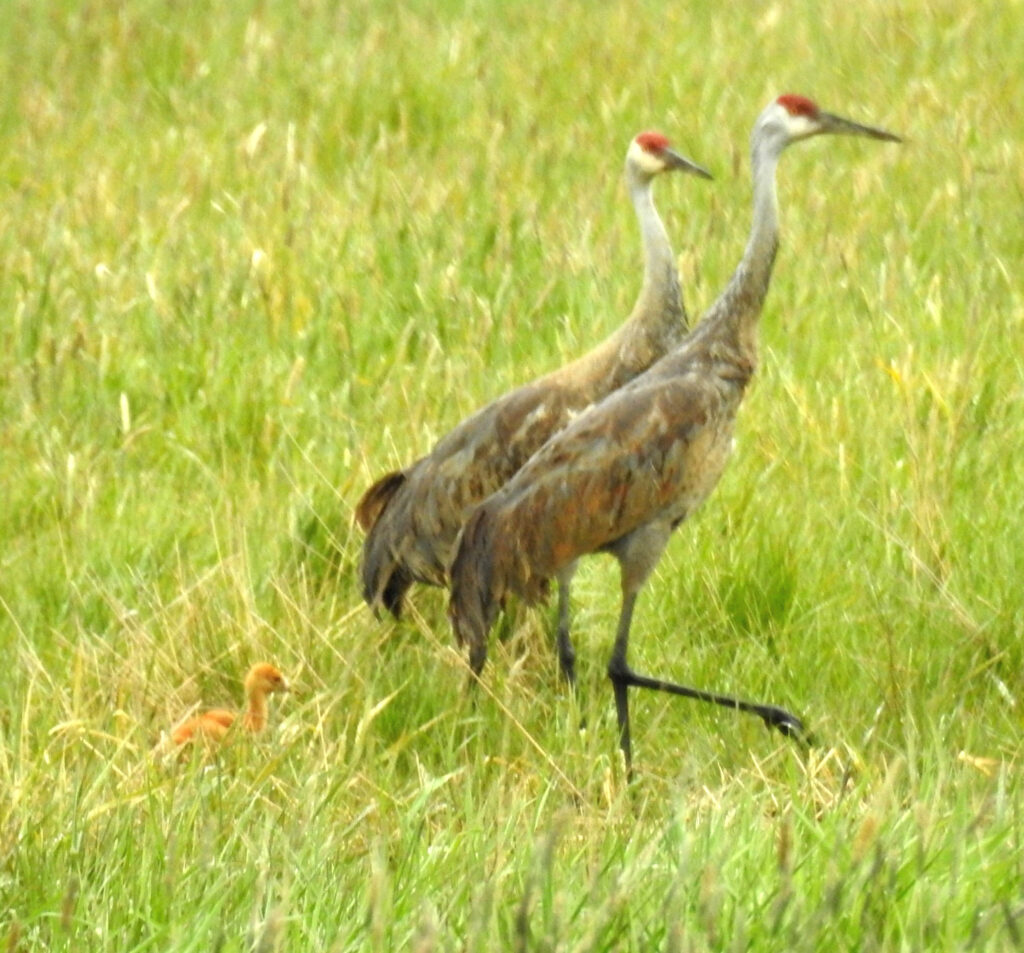By Charlie Frisk
Correspondent
This summer, I am spending more time than usual cruising the backroads east of Green Bay on my bike.
I am training for the RAGBRAI, the Register’s Annual Great Bicycle Ride Across Iowa, so I am biking at least every other day. I have been pleasantly surprised at the number of birds I see and hear from the seat of my bike.
Sandhill cranes

The area east of Green Bay has an abundance of wetlands, so I see sandhill cranes every time I ride.
Many of the pairs are accompanied by colts, the very appropriate name given to their long-legged young.
Sandhill cranes almost always lay two eggs, but many of the pairs have already lost at least one of the colts, usually thought to be due to predation.
As recently as the early 1980s, there were almost no sandhill cranes in Brown or Kewaunee County.
I participated in the Annual Midwest Crane Count, which was sponsored by the International Crane Conservancy in 1984, and our team was assigned a large area east of Green Bay.
We neither saw nor heard a single crane, and our experience was typical of most of the teams.
Today, sandhill cranes are common in any rural areas that have some wetlands.
The sandhill cranes remarkable recovery is due to protection from hunting and the restoration of their wetland habitat.
Grassland species
Most of the bird species I see while biking are grassland or wetland species.
One that I see every time I bike is a grassland sparrow called the dickcissel.
The dickcissel is one of those species for which it is easy to learn the call, as they repeat their name over and over.
They like to get up high when they call, either on the power lines or on one of the taller plants in the fields.
Two grassland species that used to be much more common in this area are the Eastern meadowlark and the bobolink.
Listen and look for them in areas with a lot of grassland – I see or hear them most days that I bike.
Both species are known for their beautiful songs – the meadowlark for its melodious chorus and the bobolink for its joyous bubbling burst.
Other common species in the farmland areas are killdeer, red-winged blackbirds, American goldfinches, Eastern kingbirds, barn swallows and tree swallows.
Loss of habitat
The majority of grassland nesting birds have experienced population declines due to a variety of causes – the most important factor being loss of habitat.
On many modern dairy farms, the cows spend their entire life inside of buildings, so the farmer has no pasture.
Pastures being replaced by row crops, such as corn and soybeans, has eliminated a lot of nesting and feeding habitat for grassland birds.
Just a few decades ago, many grassland birds nested in hayfields.
When I was in high school, I was hired by local farmers to help bale hay.
The baling season typically started after July 1, which allowed enough time for ground nesting birds to fledge their young.
With the development of higher production hybrid alfalfa and clover, farmers will typically make their first cutting in May, which does not allow even the earliest nesting birds to reproduce successfully.
Grassland birds that are insect eaters have suffered from increased use of insecticides.
Increased use of herbicides and cleaner farming techniques has eliminated a lot of the food for seed eating birds.
Future threat
The greatest future threat for many grassland birds is climate change.
It is well documented that many bird species are gradually moving their range north every year as the climate warms.
There is a limit as to how long this can work, as once they hit the forested regions of northern U.S. and Canada they will not be able to survive.
Throughout the Midwest, the most important habitat for grassland birds are the acreages that are enrolled in some type of government conservation program.
Three U.S. Department of Agriculture programs that provide millions of acres of habitat for grassland birds are the Conservation Reserve Program, CRP, the Farmable Wetlands Program and Pollinator Habitat Planting.
Farmers are paid government subsidies for enrolling acreage into these programs.
Many farmers, particularly those producing organic meat and milk, have converted to rotational grazing for raising cattle and sheep, which provides ideal habitat for birds and their food sources.
On a rotational grazing farm, the livestock is moved to a new grass plot every few days to allow the grass to recover.
Homeowners can also help birds by replacing some of their turf grass yard with native grassland species.
It might seem like a tiny area, but if enough homeowners plant natural areas, the acreage will add up.
Great for starting out
The farmland birds are great for someone just getting started at learning bird calls, as there are not so many to be overwhelming, and most of their calls are fairly distinctive.
Merlin Bird ID, Cornell and Audubon Apps are all excellent for identifying birds – both by call and visually.
With these apps, the user can photograph the bird or record the call of a bird, and the app will identify it for them.
Biking is a great way to observe farmland birds.
You can go fast enough to cover a lot of distance, but not so fast that you don’t see or hear the birds.
You should never wear headphones while biking, as they prevent you from hearing approaching vehicles, and they keep you from enjoying the bird song.
Bay Area Birds is a column written by local ornithology enthusiast Charlie Frisk.
